Directions: Complete one Article Summary for each article read. Remember to submit a copy of the article at the end of the summary. No late summaries accepted.
Include the following in your summation.
v Summary Information
w Briefly state the main idea presented in this article:
w Summarize the most important information, ideas, facts, etc. presented in this article (1 - 2 paragraphs)
v Personal Reaction
w What was the most surprising/interesting thing in this article?
w What other keywords/topics for further research did you find reading this article to contribute to marketing?
(1 -2 paragraphs)
(1 -2 paragraphs)
- Draw a conclusion about the article - is it a good or bad idea?
v Bibliographic Information - Submit in MLA format (Last Page)
REMEMBER: THIS IS ACADEMIC WRITING - DO NOT RESPOND TO ARTICLES WITH
- I THINK...
- I FEEL...
- I BELIEVE...
How much does the text agree or clash with your view of visual merchandising and what you consider right and wrong?
Use several quotes as examples of how it agrees with and supports what you think about visual merchandising, about right and wrong, and about what you think it is to be in this field.
How well does it address things that you, personally, care about and consider important? How does it address things that are important to your family, your community, your ethnic group, to people of your economic or social class or background, or your faith tradition? If not, who does or did the text serve? Did it pass the "Who cares?" test?
Use quotes to illustrate.


































